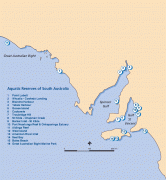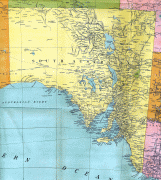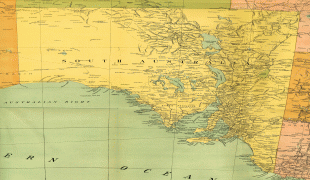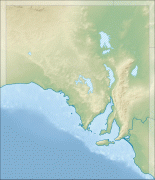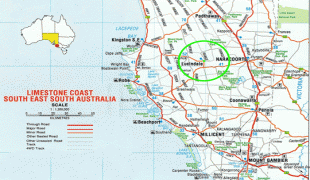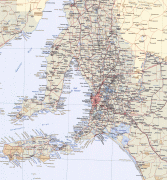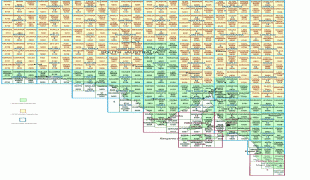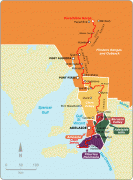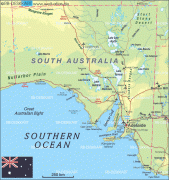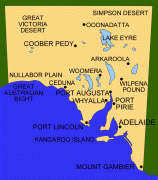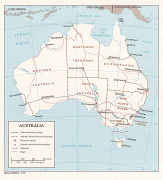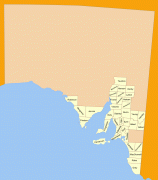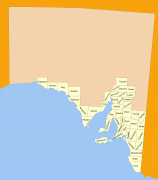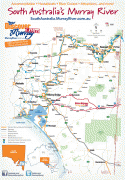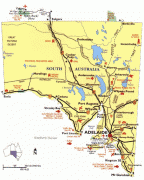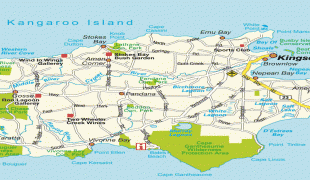South Australia (State of South Australia)
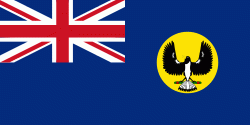 |
 |
South Australia shares borders with all of the other mainland states, as well as the Northern Territory; it is bordered to the west by Western Australia, to the north by the Northern Territory, to the north-east by Queensland, to the east by New South Wales, to the south-east by Victoria, and to the south by the Great Australian Bight. The state comprises less than 8 percent of the Australian population and ranks fifth in population among the six states and two territories. The majority of its people reside in greater Metropolitan Adelaide. Most of the remainder are settled in fertile areas along the south-eastern coast and River Murray. The state's colonial origins are unique in Australia as a freely settled, planned British province, rather than as a convict settlement. Colonial government commenced on 28 December 1836, when the members of the council were sworn in near the Old Gum Tree.
As with the rest of the continent, the region has a long history of human occupation by numerous tribes and languages. The South Australian Company established a temporary settlement at Kingscote, Kangaroo Island, on 26 July 1836, five months before Adelaide was founded. The guiding principle behind settlement was that of systematic colonisation, a theory espoused by Edward Gibbon Wakefield that was later employed by the New Zealand Company. The goal was to establish the province as a centre of civilisation for free immigrants, promising civil liberties and religious tolerance. Although its history has been marked by periods of economic hardship, South Australia has remained politically innovative and culturally vibrant. Today, it is known for its fine wine and numerous cultural festivals. The state's economy is dominated by the agricultural, manufacturing and mining industries.
Evidence of human activity in South Australia dates back as far as 20,000 years, with flint mining activity and rock art in the Koonalda Cave on the Nullarbor Plain. In addition wooden spears and tools were made in an area now covered in peat bog in the South East. Kangaroo Island was inhabited long before the island was cut off by rising sea levels. According to mitochondrial DNA research, Aboriginal people reached Eyre Peninsula 49,000-45,000 years ago from both the east (clockwise, along the coast, from northern Australia) and the west (anti-clockwise).
The first recorded European sighting of the South Australian coast was in 1627 when the Dutch ship the Gulden Zeepaert, captained by François Thijssen, examined and mapped a section of the coastline as far east as the Nuyts Archipelago. Thijssen named the whole of the country eastward of the Leeuwin "Nuyts Land", after a distinguished passenger on board; the Hon. Pieter Nuyts, one of the Councillors of India.
The coastline of South Australia was first mapped by Matthew Flinders and Nicolas Baudin in 1802, excepting the inlet later named the Port Adelaide River which was first discovered in 1831 by Captain Collet Barker and later accurately charted in 1836–37 by Colonel William Light, leader of the South Australian Colonization Commissioners' 'First Expedition' and first Surveyor-General of South Australia.
The land which now forms the state of South Australia was claimed for Britain in 1788 as part of the colony of New South Wales. Although the new colony included almost two-thirds of the continent, early settlements were all on the eastern coast and only a few intrepid explorers ventured this far west. It took more than forty years before any serious proposal to establish settlements in the south-western portion of New South Wales were put forward.
On 15 August 1834, the British Parliament passed the South Australia Act 1834 (Foundation Act), which empowered His Majesty to erect and establish a province or provinces in southern Australia. The act stated that the land between 132° and 141° east longitude and from 26° south latitude to the southern ocean would be allotted to the colony, and it would be convict-free.
In contrast to the rest of Australia, terra nullius did not apply to the new province. The Letters Patent, which used the enabling provisions of the South Australia Act 1834 to fix the boundaries of the Province of South Australia, provided that "nothing in those our Letters Patent shall affect or be construed to affect the rights of any Aboriginal Natives of the said Province to the actual occupation and enjoyment in their own Persons or in the Persons of their Descendants of any Lands therein now actually occupied or enjoyed by such Natives." Although the patent guaranteed land rights under force of law for the indigenous inhabitants, it was ignored by the South Australian Company authorities and squatters. Despite strong reference to the rights of the native population in the initial proclamation by the Governor, there were many conflicts and deaths in the Australian Frontier Wars in South Australia.
Survey was required before settlement of the province, and the Colonization Commissioners for South Australia appointed William Light as the leader of its 'First Expedition', tasked with examining 1500 miles of the South Australian coastline and selecting the best site for the capital, and with then planning and surveying the site of the city into one-acre Town Sections and its surrounds into 134-acre Country Sections.
Map - South Australia (State of South Australia)
Map
Country - Australia
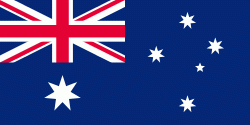 |
 |
| Flag of Australia | |
The ancestors of Aboriginal Australians began arriving from south east Asia approximately 65,000 years ago, during the last ice age. Arriving by sea, they settled the continent and had formed approximately 250 distinct language groups by the time of European settlement, maintaining some of the longest known continuing artistic and religious traditions in the world. Australia's written history commenced with the European maritime exploration of Australia. The Dutch navigator Willem Janszoon was the first known European to reach Australia, in 1606. In 1770, the British explorer James Cook mapped and claimed the east coast of Australia for Great Britain, and the First Fleet of British ships arrived at Sydney in 1788 to establish the penal colony of New South Wales. The European population grew in subsequent decades, and by the end of the 1850s gold rush, most of the continent had been explored by European settlers and an additional five self-governing British colonies established. Democratic parliaments were gradually established through the 19th century, culminating with a vote for the federation of the six colonies and foundation of the Commonwealth of Australia on 1 January 1901. Australia has since maintained a stable liberal democratic political system and wealthy market economy.
Currency / Language
| ISO | Currency | Symbol | Significant figures |
|---|---|---|---|
| AUD | Australian dollar | $ | 2 |
| ISO | Language |
|---|---|
| EN | English language |






